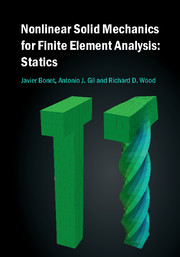Refine search
Actions for selected content:
6993 results in Mathematical modeling and methods

Nonlinear Solid Mechanics for Finite Element Analysis: Statics
-
- Published online:
- 05 June 2016
- Print publication:
- 23 June 2016
ANZ VOLUME 57 ISSUE 4 COVER AND BACK MATTER
-
- Journal:
- The ANZIAM Journal / Volume 57 / Issue 4 / April 2016
- Published online by Cambridge University Press:
- 31 May 2016, pp. b1-b8
-
- Article
-
- You have access
- Export citation
Dedication
-
- Book:
- Fourier Analysis
- Published online:
- 05 May 2016
- Print publication:
- 31 May 2016, pp v-vi
-
- Chapter
- Export citation
Contents
-
- Book:
- Fourier Analysis
- Published online:
- 05 May 2016
- Print publication:
- 31 May 2016, pp vii-x
-
- Chapter
- Export citation
4 - Convergence results for Fourier series
-
- Book:
- Fourier Analysis
- Published online:
- 05 May 2016
- Print publication:
- 31 May 2016, pp 159-198
-
- Chapter
- Export citation
5 - Fourier transforms
-
- Book:
- Fourier Analysis
- Published online:
- 05 May 2016
- Print publication:
- 31 May 2016, pp 199-216
-
- Chapter
- Export citation
2 - The Lebesgue measure and integral
-
- Book:
- Fourier Analysis
- Published online:
- 05 May 2016
- Print publication:
- 31 May 2016, pp 15-70
-
- Chapter
- Export citation
ANZ VOLUME 57 ISSUE 4 COVER AND FRONT MATTER
-
- Journal:
- The ANZIAM Journal / Volume 57 / Issue 4 / April 2016
- Published online by Cambridge University Press:
- 31 May 2016, pp. f1-f2
-
- Article
-
- You have access
- Export citation
6 - Multi-dimensional Fourier analysis
-
- Book:
- Fourier Analysis
- Published online:
- 05 May 2016
- Print publication:
- 31 May 2016, pp 217-272
-
- Chapter
- Export citation
Afterword
-
- Book:
- Fourier Analysis
- Published online:
- 05 May 2016
- Print publication:
- 31 May 2016, pp 335-336
-
- Chapter
- Export citation
3 - Elements of functional analysis
-
- Book:
- Fourier Analysis
- Published online:
- 05 May 2016
- Print publication:
- 31 May 2016, pp 71-158
-
- Chapter
- Export citation
7 - A glance at some advanced topics
-
- Book:
- Fourier Analysis
- Published online:
- 05 May 2016
- Print publication:
- 31 May 2016, pp 273-334
-
- Chapter
- Export citation
Preface
-
- Book:
- Fourier Analysis
- Published online:
- 05 May 2016
- Print publication:
- 31 May 2016, pp xi-xiv
-
- Chapter
- Export citation
Frontmatter
-
- Book:
- Fourier Analysis
- Published online:
- 05 May 2016
- Print publication:
- 31 May 2016, pp i-iv
-
- Chapter
- Export citation
References
-
- Book:
- Fourier Analysis
- Published online:
- 05 May 2016
- Print publication:
- 31 May 2016, pp 343-348
-
- Chapter
- Export citation
1 - Introduction
-
- Book:
- Fourier Analysis
- Published online:
- 05 May 2016
- Print publication:
- 31 May 2016, pp 1-14
-
- Chapter
- Export citation
Index
-
- Book:
- Fourier Analysis
- Published online:
- 05 May 2016
- Print publication:
- 31 May 2016, pp 349-353
-
- Chapter
- Export citation
Appendix - Historical notes
-
- Book:
- Fourier Analysis
- Published online:
- 05 May 2016
- Print publication:
- 31 May 2016, pp 337-342
-
- Chapter
- Export citation
EXACT ANALYTICAL EXPRESSIONS FOR THE FINAL EPIDEMIC SIZE OF AN SIR MODEL ON SMALL NETWORKS
- Part of
-
- Journal:
- The ANZIAM Journal / Volume 57 / Issue 4 / April 2016
- Published online by Cambridge University Press:
- 23 May 2016, pp. 429-444
-
- Article
-
- You have access
- Export citation
A WAVELET COLLOCATION SCHEME FOR SOLVING SOME OPTIMAL PATH PLANNING PROBLEMS
- Part of
-
- Journal:
- The ANZIAM Journal / Volume 57 / Issue 4 / April 2016
- Published online by Cambridge University Press:
- 12 May 2016, pp. 461-481
-
- Article
-
- You have access
- Export citation


